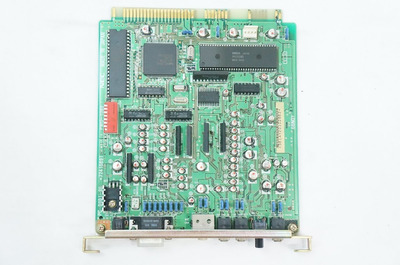It should be perfectly possible to get the YM2608 on an ISA bus, actually almost trivial as long as it's an 8-bit card. Mostly you'll want to find four consecutive addresses in PC I/O space that isn't going to already have something else mapped to it, then check all the upper bits but two for a match to get your chip select signal, then use the two bottom bits as your A0 and A1 inputs to the chip. The decoder match is probably going to produce a logic high, so you'll want to feed that into a NOT gate, and use that as your YM2608 chip-select line. You'll want to NOR (functionally an active-low AND) together the address-decode-match-chip-select line with the ISA IOR and IOW lines, then use the IOR and IOW as your RD and WR signals. (active-low inputs CS and IOW NORed to active-low output WR, active-low inputs CS and IOR NORed to active-low output RD)
You mentioned DMA, but that's completely unnecessary for a chip like the YM2608. You could potentially have samples to upload, but on the PC, i8237 DMA tends to be slower than programmed I/O, and has a large number of restrictions. (DMA copy length, where can and can't be gone from and to, low number of DMA channels, etc).
You can do ROM or RAM for samples, I think you can upload samples to the sample RAM by interacting with the registers of the 2608 itself. If not, I don't know why it would have a WE pin intended to go from the chip itself to a DRAM. I'm not familiar enough with the 2608 or the other Yamaha chips with sample playback to be able to tell you whether you'll need some way to tell the CPU to delay writes if the chip is refreshing its DRAM or if it gets access contention while playing a sample or something.
You'll want to have your own 8MHz crystal on the board to clock the chip, ISA won't provide any consistent clock-source (besides a 14.38Mhz one, which some boards don't implement...)
If you feel like 6 FM channels, 3 AY-3-8910 channels, some random percussion, and one ADPCM isn't enough, you can always add another chip. 🙃
